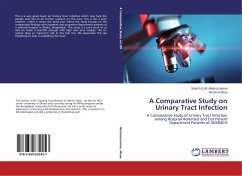
Incidence of antibiotic resistance in bacteria causing urinary tract infection
Versandkostenfrei!
Versandfertig in 6-10 Tagen
27,99 €
inkl. MwSt.

PAYBACK Punkte
14 °P sammeln!
Urinary tract infection has always been a problem of concern to the medical community, because the damage caused by this pathology can alter the body's proper functioning and cause irreversible after-effects. The importance of this infectious disease stems from its incidence and the difficulty of treating it in the presence of multi-resistant bacteria. This work involves bibliographic research into urinary tract infection, from an anatomical and pathophysiological point of view, as well as its incidence and the antibiotic resistance of the bacteria responsible. According to national and intern...
Urinary tract infection has always been a problem of concern to the medical community, because the damage caused by this pathology can alter the body's proper functioning and cause irreversible after-effects. The importance of this infectious disease stems from its incidence and the difficulty of treating it in the presence of multi-resistant bacteria. This work involves bibliographic research into urinary tract infection, from an anatomical and pathophysiological point of view, as well as its incidence and the antibiotic resistance of the bacteria responsible. According to national and international studies on antibiotic resistance, enterobacteria are the main cause of urinary tract infections. Escherichia coli is the most frequently encountered, with high levels of resistance to the various antibiotics, including families of the beta-lactamase class such as cephalosporins, but remains sensitive to carbapenems. This resistance is increasing day by day, due to the natural selection of bacteria, which is exacerbated by overuse of antibiotics.












